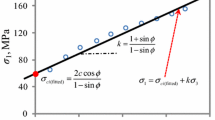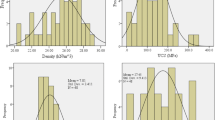Abstract
The geometrical and mechanical properties of joints play an important role in the determination of shear strength of jointed rocks. In this research, we propose a nonlinear model to estimate the shear strength of jointed rocks with unfilled saw-tooth triangular asperities using the basic friction angle φb, the tensile strength of intact rock σt, and the joint inclination angle i under various normal stress σn conditions. In order to propose the new shear strength model, firstly, a rock database of saw-tooth jointed rocks containing experimental and numerical data is established. The experimental data are collected from publications. The numerical data are generated by the particle flow code (PFC) model. Then, the genetic programming (GP) is used to analyze the database to propose the GP shear strength model. The prediction performance of the proposed GP model is tested and compared with that of the Patton model and the Ladanyi and Archambault (LA) model. Comparison results show that the proposed GP model has the best prediction performance compared with the Patton model and the LA model. The proposed GP model can capture the nonlinear shear strength behavior of saw-tooth jointed rocks and its input parameters can be easily estimated.









Similar content being viewed by others
Data availability
We declared that the data and materials described in the manuscript will be available to researchers who want to use them for non-commercial purposes.
References
Alazba A, Yassin M, Mattar M (2016) Modeling daily evapotranspiration in hyper-arid environment using gene expression programming. Arab J Geosci 9:202
Bahaaddini M, Sharrock G, Hebblewhite B (2013) Numerical direct shear tests to model the shear behaviour of rock joints. Comput Geotech 51(51):101–115
Bahaaddini M, Hagan P, Mitra R, Hebblewhite B (2015) Parametric study of smooth joint parameters on the shear behaviour of rock joints. Rock Mech Rock Eng 48(3):923–940
Ban L, Du W, Qi C (2020) A modified roughness index based on the root mean square of the first derivative and its relationship with peak shear strength of rock joints. Eng Geol 279:105898. https://doi.org/10.1016/j.enggeo.2020.105898
Barton N, Choubey V (1977) The shear strength of rock joints in theory and practice. Rock Mech 10:1–54
Cabalar A, Cevik A (2009) Genetic programming-based attenuation relationship: an application of recent earthquakes in turkey. Comput Geosci 35(9):1884–1896
Cundall P, Potyondy D (2004) A bonded-particle model for rock. Int J Rock Mech Min Sci 41(8):1329–1364
Farrokhi F, Firoozfar A, Maghsoudi M (2020) Evaluation of liquefaction-induced lateral displacement using a GMDH-type neural network optimized by genetic algorithm. Arab J Geosci 13:4
Grasselli G, Egger P (2003) Constitutive law for the shear strength of rock joints based on three-dimensional surface parameters. Int J Rock Mech Min Sci 40:25–40
Huang F, Shen J, Cai M, Xu C (2019) An empirical UCS model for anisotropic blocky rock masses. Rock Mech Rock Eng 52:3119–3131
Huang H, Shen J, Chen Q, Karakus M (2020) Estimation of REV for fractured rock masses based on Geological Strength Index. Int J Rock Mech Min Sci 126:104179
Javadi A, Rezania M, Nezhad M (2006) Evaluation of liquefaction induced lateral displacements using genetic programming. Comput Geotech 33(4-5):222–233
Karakus M (2011) Function identification for the intrinsic strength and elastic properties of granitic rocks via genetic programming (GP). Comput Geosci 37:1318–1323
Koza J (1992) Genetic programming: on the programming of computers by means of natural selection, vol 1992. MIT Press, Cambridge, p 819
Kulatilake P, Shou G, Huang T, Morgan R (1995) New peak shear strength criteria for anisotropic rock joints. Int J Rock Mech Min Sci Geomech Abstr 32(7):673–697
Ladanyi B, Archambault G (1969) Simulation of shear behavior of a jointed rock mass. Paper presented at the 11th US Rock Mechanics Symposium (USRMS), Berkeley
Li Y, Oh J, Mitra R, Hebblewhite B (2016) Experimental studies on the mechanical behavior of rock joints with various openings. Rock Mech Rock Eng 49(3):837–853
Lin H, Xie S, Yong R, Chen Y, Du S (2019) An empirical statistical constitutive relationship for rock joint shearing considering scale effect. C R Mécanique 347(8):561–575
Liu Q, Tian Y, Liu D, Jiang Y (2017) Updates to jrc-jcs model for estimating the peak shear strength of rock joints based on quantified surface description. Eng Geol 228:282–300
Patton F (1966) Multiple modes of shear failure in rock. Paper presented at the 1st ISRM Congress, Lisbon
Rahgoshay M, Feiznia S, Arian M, Hashemi S (2019) Simulation of daily suspended sediment load using an improved model of support vector machine and genetic algorithms and particle swarm. Arab J Geosci 12:277
Salmasi F, Yıldırım G, Masoodi A, Parsamehr P (2013) Predicting discharge coefficient of compound broad-crested weir by using genetic programming (GP) and artificial neural network (ANN) techniques. Arab J Geosci 6:2709–2717
Shen J, Jimenez R (2018) Predicting the shear strength parameters of sandstone using genetic programming. Bull Eng Geol Environ 77(4):1647–1662
Shen J, Karakus M, Xu C (2012) Direct expressions for linearization of shear strength envelopes given by the generalized Hoek-Brown criterion using genetic programming. Comput Geotech 44:139–146
Shen J, Zhan S, Karakus M, Zuo J (2020) Effects of flaw width on cracking behavior of single-flawed rock specimens. Bull Eng Geol Environ 80:1701–1711. https://doi.org/10.1007/s10064-020-02029-w
Silva S (2007) A genetic programming toolbox for MATLAB: Version 3, 2007. Available online at: http://switch.dl.sourceforge.net/sourceforge/gplab/. (Sep. 10, 2016)
Tang Z, Wong N (2016) New criterion for evaluating the peak shear strength of rock joints under different contact states. Rock Mech Rock Eng 49(4):1191–1199
Tang Z, Wong N, Jiao Y, Wang X (2016) Choosing appropriate parameters for developing empirical shear strength criterion of rock joint: review and new insights. Rock Mech Rock Eng 49(11):4479–4490
Tang X, Rutqvist J, Hu M, Rayudu N (2019) Modeling three-dimensional fluid-driven propagation of multiple fractures using TOUGH-FEMM. Rock Mech Rock Eng 52(2):611–627
Tian Y, Liu Q, Ma H, Liu Q, Deng P (2018) New peak shear strength model for cement filled rock joints. Eng Geol 233:269–280
Uysal F (2020) Prediction of collapse potential of soils using gene expression programming and parametric study. Arab J Geosci 13:1038
Yong R, Ye J, Li B, Du S (2018) Determining the maximum sampling interval in rock joint roughness measurements using Fourier series. Int J Rock Mech Min Sci 101:78–88
Zhou C, Xu C, Karakus M, Shen J (2018) A systematic approach to the calibration of micro-parameters for the flat-jointed bonded particle model. Geomech Eng 16(5):471–482
Acknowledgments
This research was funded by the National Natural Science Foundation of China (No. 51504218).
Code availability
Not applicable.
Funding
This research was funded by the National Natural Science Foundation of China (No. 51504218).
Author information
Authors and Affiliations
Corresponding author
Ethics declarations
Conflict of interest
The authors declared that they have no conflicts of interest to this work.
Additional information
Responsible Editor: Murat Karakus
Rights and permissions
About this article
Cite this article
Shen, J., Shang, W., Cedrick, M. et al. Predicting the shear strength of saw-tooth jointed rocks using genetic programming. Arab J Geosci 14, 358 (2021). https://doi.org/10.1007/s12517-021-06662-x
Received:
Accepted:
Published:
DOI: https://doi.org/10.1007/s12517-021-06662-x




